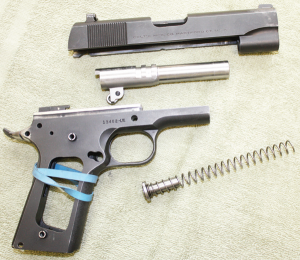By Dave Workman | Senior Editor
Humbly speaking, as I realize there will be immediate disagreement, it is my opinion that the .45-caliber semi auto pistol on a Colt Commander-sized frame is quite possibly the best defensive sidearm on the map, provided one knows how to use it.
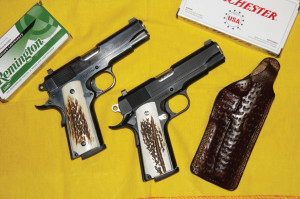
Author’s two Commanders, the all-steel Combat Commander (left) and the newly assembled Lightweight, decked out with a set of genuine stag grip panels. Both fit snugly in the same holster.
It also happens to be a pretty good “working” pistol; that is, a gun one carries daily Proficiency takes practice, of course.
That explains why some people, me included, have spent countless hours at the range burning up thousands of rounds of ammunition, honing our shooting skills. Still, we are all looking for some kind of an “edge,” a gimmick, perhaps, or maybe just the “perfect” pistol.
There is no such thing as a perfect pistol. It does not exist. What we have is the next best thing; some pistols do turn out to be best for some shooters.
The rest of us experiment around until we find a gun that fits our needs, is reliable, comfortable, affordable, and fits the hand.
In my case, that turned out to be a Model 1911 with a flat mainspring housing. The curved housing simply doesn’t fit my hand comfortably.
There are some swell handguns in .45 ACP built on the 1911 platform, from Kimber, Springfield Armory, Dan Wesson, Sig Sauer, Smith & Wesson and any number of other makers, including the big name “custom” shops such as Les Baer and Wilson Combat.
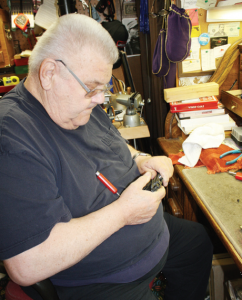
Gunsmith Tim McCullough is shown hand-fitting the slide and frame of a Lightweight Commander “project gun” he put together from parts.
I own a good compact Kimber that is a fine and accurate specimen, and I carry it on many occasions. My Springfield government model is a 25-yard hole-puncher.
But for everyday street carry, I really like the Colt Commander, and I’ve got a vintage 1964 Combat Commander with the steel frame to which has only been added a set of superb Trijicon tritium night sights, a Wilson beavertail grip safety and a pair of genuine stag grips I acquired in an oddball purchase via the Internet.
I concluded some time ago that a single stack, single-action .45 on the Model 1911 frame with a 4.25-inch barrel just might provide the best balance for a street carry gun, at least for my requirements.
It draws fast, comes up on target, is a bit more easily concealed than a fullsized Government Model and with a lightweight frame, it doesn’t become an anchor at the end of the day.
Yet, I have been delighted with my all-steel Combat Commander, and it has traveled with me to a number of places in all kinds of weather conditions, and never failed.
Late last year, my longtime pal and retired gunsmith Tim McCullough launched a little project that has turned out to be a gem. He’d known of my interest in a Lightweight Commander, and asked if I’d be interested in the finished product.
I’d had some previous experience with one of McCullough’s project guns. The earlier creation, on an Officer’s Model platform from stainless parts, is a remarkable shooter. I had the opportunity to fire that pistol quite a bit, and actually built a custom cross-draw belt slide holster for the gun at Tim’s request. He carries it regularly, I’m told.
The result of this Lightweight project was an accurate, tight and reliable “parts pistol” that will stack up to anything from an assembly line.
I obtained another set of Trijicon sights and just happened to have another pair of stag grips that needed a home. A working pistol is well-equipped with night sights, because gun battles do not always happen in the daylight, and in my travels around the Pacific Northwest outdoors, I’ve run into coyotes and other things with teeth early in the morning and late in the evening. In subdued light, which we have a lot of in Western Washington from late September through at least mid-April, that extra tritium edge can literally be a life saver, and each of my carry pistols has some type of night sight. Three of them are fitted with Trijicons, and they have been through a lot in the field. I’m not certain what the service life of these sights is, but the set I’ve got on my Springfield still have a pretty decent glow and they were put on sometime in the mid-1990s.
I will be brutally honest about this: The original low-profile factory sights Colt put on this model are simply not up to snuff for me, and now that I’ve been wearing eyeglasses for nearly 30 years, the small Colt front sight is damn near useless. I’ve never been able to pick it up reliably, especially for second shots, and while others seem to do okay with those old factory sights, I do not. In subdued light, I may as well be shooting from the hip or wearing a blindfold.
To Colt’s credit, the factory sights of today are higher-profile and constitute a vast improvement over the specimens from the early production years of this gun.
Vintage Slide, frame
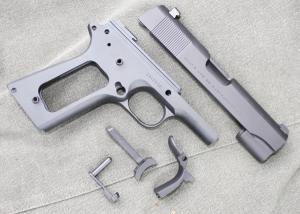
AFTER: And this is what the frame and slide looked like after being finished and prior to final assembly.
Truth be known, I think McCullough just likes to tinker around with Model 1911 pistols. He used to have an impressive collection of them dating back to WWI, but now in his 70s, he is also paying attention to a really sharp Shelby Cobra that he had acquired. The last time I visited at his house, he showed it to me. It has all the makings of a muzzle velocity rocket on four wheels. But attention to his car did not distract McCullough from the business at hand.
McCullough told me the slide was from 1951, the first year that the Commander was in full commercial production, according to a brief history of the model I found online. He said the frame was manufactured sometime in 1953, and one glance told me it was in really good shape.
If one cruises around gun shows, components like this show up from time to time. The home gunsmith can come up with some treasures by shopping around and carefully examining certain “finds.”
Back in the early 1950s when these parts were manufactured, the pistol was offered in 9mm, .38 Super and .45 ACP. I’ve never quite understood why the military wanted sidearms for their officers in 9mm, because the .45 is a body-slammer and it was the duty caliber at the time. Adding the .38 Super made more sense. It’s a sizzler that has been known to stop a few gunfights.
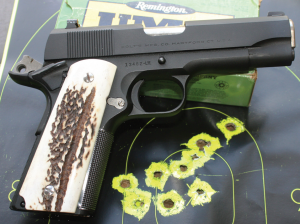
Here’s a typical 25-yard group the lightweight pistol can produce. Workman
carries the pistol with an eight-round McCormick magazine and one up the spout
for nine decisive rounds.
The McCullough project pistol has a stainless steel match-grade barrel and stainless steel bushing, plus a stainless magazine release and ring-style Commander hammer. Everything else wears some kind of a tough black finish that seems very durable and non-reflective.
The flat checkered mainspring housing is synthetic, and to be honest, I happen to like those. I’ve got them on three of my pistols and never had a bit of trouble with any of them.
Unlike my all-steel version, the Lightweight was fitted with an ambidextrous thumb safety. This addition gives me more incentive to shoot the pistol left-handed.
He carefully fitted the beavertail safety to the frame so that the surfaces matched, and the trigger lets off at 4.5 pounds, just where I like it for a street gun.
A word about the trigger in this pistol. This was what one might call a “McCullough Special.” He used a standard Colt short trigger—which I prefer—and he drilled and tapped it for an adjustment screw. The result is one of the cleanest-breaking triggers I’ve ever pressed. And it’s just a worked over GI trigger. It was a small touch, but an important one.
One thing about a “project” pistol like this is that you know everything will be hand-fitted. I have known people who toiled for hours with fine stones and lapping compounds to align, smooth and polish surfaces for precision, and this much seems evident with the Lightweight. McCullough showed me the parts a couple of times while the work was in progress, and it was very educational to see how he trued up the rails and got it all together.
The finished piece is very striking, and it contrasted nicely with the stag grip panels.
But does it shoot?
Okay, good looks only go so far. How well does this thing shoot? The answer: Just great! The first seven rounds at 15 yards off a sandbag rest were in a tight little group in and around the X-ring, and the next seven just made the hole bigger.
I had a tin can and tossed it out to about 10 yards and just started bouncing it around, all with 230-grain FMJ ammunition, mind you. At one point I had spun the can around to where I was shooting at the bottom, and I still made the thing bounce.
I much prefer tin cans to aluminum for targets because it has been my experience that the softer aluminum will crumple rather than bounce around because tin is harder and when it is hit, it has a bit of resistance, thus making it bounce or roll. This is important because it forces a shooter to follow a moving target.
I shifted from 230-grainers to 185- grain JHP handloads and still got good results. The bullets were a mix of Nosler’s superb JHPs that I’ve had on a shelf for a while, and some newer loads with Montana Gold hollowpoints, propelled along by 6.2 grains of Hodgdon’s HP 38 over a CCI large pistol primer. I printed one nine-shot string across the center of a target.
Honestly, I couldn’t wait to give Tim a call and let him know that the project gun was a keeper.
Perhaps the best residual effect of having this lightweight pistol in hand was that no new leather was necessary.
Everything that the Combat Commander fit also wraps nicely around the Lightweight, from my own D&D Gunleather IWB rig to a horsehide belt holster Greg Kramer built for me several years ago, and a different IWB rig from High Noon that I’ve had for a while.
In addition, I have packed this pistol a few times in a belt rig I put together a few years ago because it draws fast and looks good.
But the main thing is that a defensive pistol shoots well, which means accurately and reliably. That, it does! I’ve known people over the years that carried Lightweight Commanders, and on the occasions they tried transitioning to something else, they almost always came back to the tough little single-action in .45 ACP. I have seen these pistols with no more alterations than a set of wrap-around Pachmayr grips, and at other times they have been tricked out elaborately with Smith & Wesson adjustable rear sights, muzzle brakes, exotic grip panels and various other things that may have looked flashy but didn’t make the gun shoot any better.
My carry pistols are all “working” guns rather than “display” models. I’m not a collector in the traditional sense.
Any gun I own is going to be fired and it better work. The tritium sights and after-market grips are about as far as it goes in terms of sprucing things up, and I think any Model 1911 needs a beavertail grip safety because those old factory originals can beat the heck out of somebody’s hand.
As I write this, Tim’s “project gun” is waiting for its next little adventure down the road or out in the field. As Humphrey Bogart said to Claude Rains at the end of Casablanca, I think this is the beginning of a beautiful friendship.

